I’ve field-tested both the Vortex and Sig Sauer sights and I continue to use both to this day.
Since they’re around the same price point, it’s natural to wonder about the comparisons of the Vortex Crossfire VS Sig Sauer Romeo 5 red dot sights.
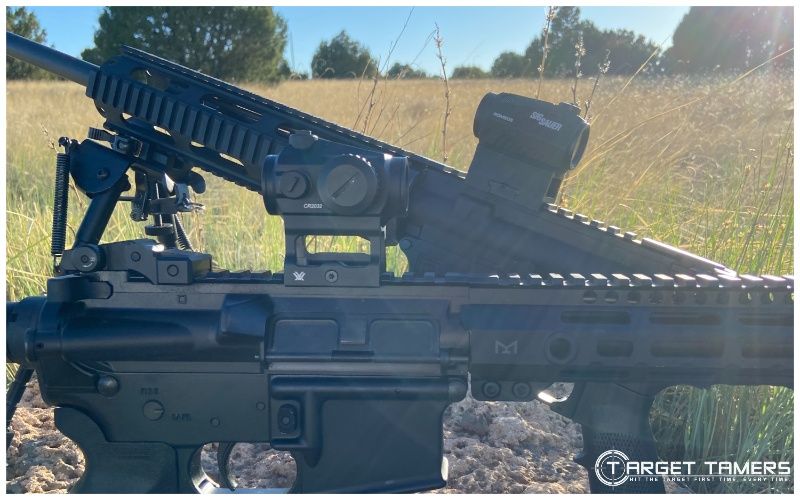
Both the Crossfire and the Romeo 5 are considered the most affordable red dot sights both manufacturers have to offer.
Because they are constantly considered in the same shortlist, I compare the optical quality, illumination, battery life, size, special features, and more in detail.
Bear with me as I rant about and praise various aspects of the Vortex and Sig sights as learned from my hands-on experience that continues to this day. Seriously – I spill updates on both these red dots that you don’t want to miss!
Quick Comparison Overview & Table
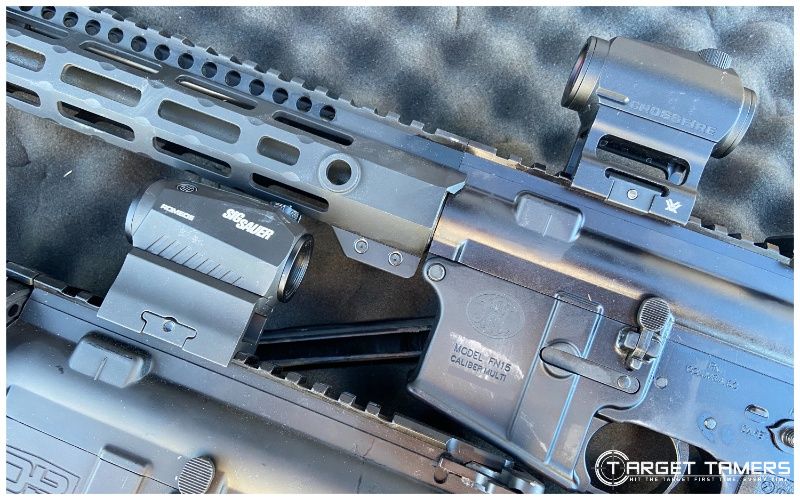
The Sig Sauer Romeo 5 will immediately top the shortlist for its MOTAC feature and button operation. The Vortex Crossfire is closely considered for its fantastic battery runtime, ease of use, and unparalleled warranty coverage.
Though they share the same configuration, dot size, and battery type, they’re different enough to warrant careful consideration before buying.
By the way, if you want more in-depth detail on either of these other red dot sights (complete with videos), check out my comprehensive hands-on reviews here:
| Features | Vortex Crossfire | Sig Sauer Romeo 5 |
|---|---|---|
| Price Range | Under $150 | Under $150 |
| Configuration | 1x20 | 1x20 |
| Dot Size | 2 MOA | 2 MOA |
| Adjustment Value | 1 MOA | 0.5 MOA |
| Turret Type | Capped | Capped |
| Illumination Settings | 9 DL / 2 NV | 8 DL/2 NV |
| Illumination Control | Knob | Buttons |
| Battery Life | 50,000 hours | 40,000+ hours |
| Battery Type & Location | CR2032 – side-loading | CR2032 - side-loading |
| Mounts | Lower 1/3 co-witness & low profile mounts | Absolute co-witness & low-profile mounts |
| Dimensions | 2.5” L | 2.4 x 1.5 x 1.5” |
| Weight | 5.2 oz | 5.1 oz |
| Waterproof | IPX7 | IPX7 |
| Lens Caps | Rubber bikini | Rubber bikini |
| Special Features | Continuous-on | MOTAC |
Why Trust Me?
After hundreds of hours of hand-testing red dot sights in the field and on the hunt, and thousands more hours researching, writing, photographing and creating videos about them, I feel I have earned the title of expert when it comes to optics!
Optics are not just my passion, but also my full-time job!
I get my hands on as many of the optics I test as possible (through buying, borrowing or begging!) and run them through their paces to make sure they will perform out in field.
Check out our optics testing process here.
Over a decade of experience target shooting, CQB and SHTF has been integral in putting together this Vortex Crossfire and Sig Sauer Romeo 5 comparison.
Feature Comparisons of the Vortex Crossfire VS Sig Sauer Romeo 5
Cost
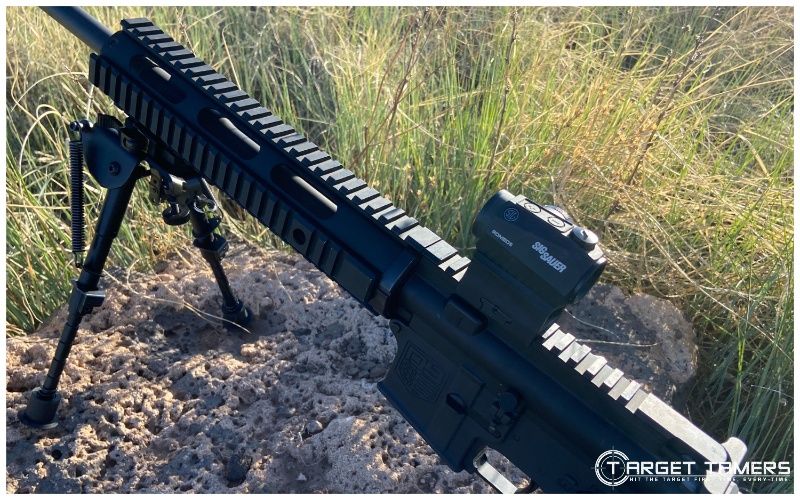
On average, the Vortex Crossfire and the Sig Sauer Romeo 5 are similar in price. At street prices they cost around $150. They’re both considered among the best budget red dot sights for the money, but the Romeo 5 offers a few more features that makes it a favorite.
Though I could call this a tie between the Vortex and the Sig sights, I see the Romeo 5 on sale for under $120 more often than I do the Crossfire. With that said, the Romeo 5 is generally more affordable than the Crossfire throughout the year.
Winner: Sig Sauer Romeo 5
Optical Quality
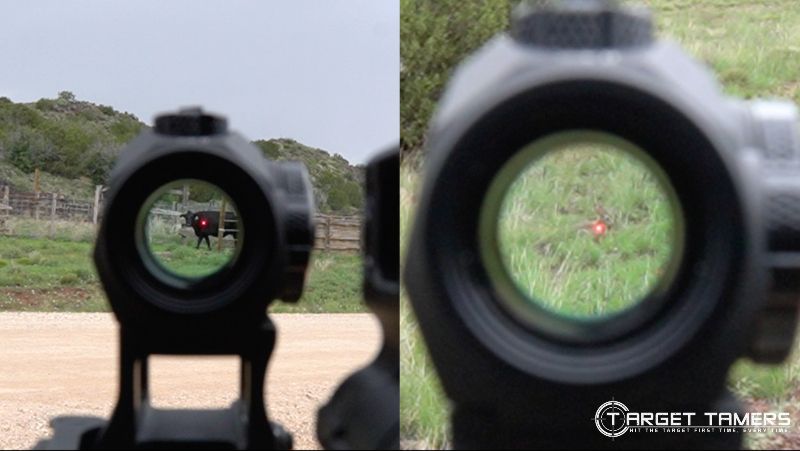
The glass quality of the Sig Sauer Romeo 5 and the Vortex Crossfire ii are above average for what is expected of a budget optic red dot sight. Both have FMC (Fully Multi-Coated) optics to improve light transmission, and both have dichroic coatings that give off a blue tint to the optics.
Though the Crossfire is great, and I have zero bones to pick with the optical system, I find the Romeo 5 to be slightly sharper with excellent color fidelity. The blue tint is much more obvious with the Crossfire.
Winner: Sig Sauer Romeo 5
Build Quality

The Sig Sauer Romeo 5 is waterproof rated with an IPX7 rating. The Vortex Crossfire does not list any waterproofing specs. However, I’m confident it’s about equal in waterproofness to the Romeo 5. Both show evidence of being fogproof though it’s not specifically marketed.
I gave the Crossfire a really hard time by completely submerging it for 30 minutes. The Romeo 5 was left out in a downpour for 60 minutes during Monsoon season. Both have lived to tell the tale with no signs of internal condensation or electrical issues.
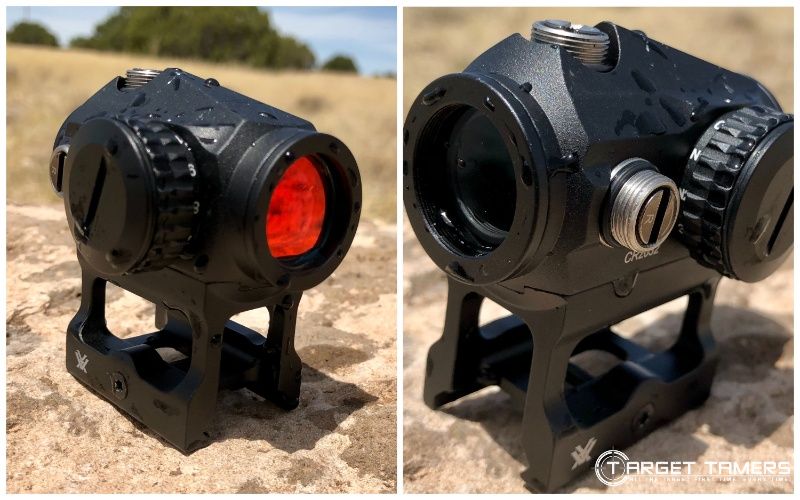
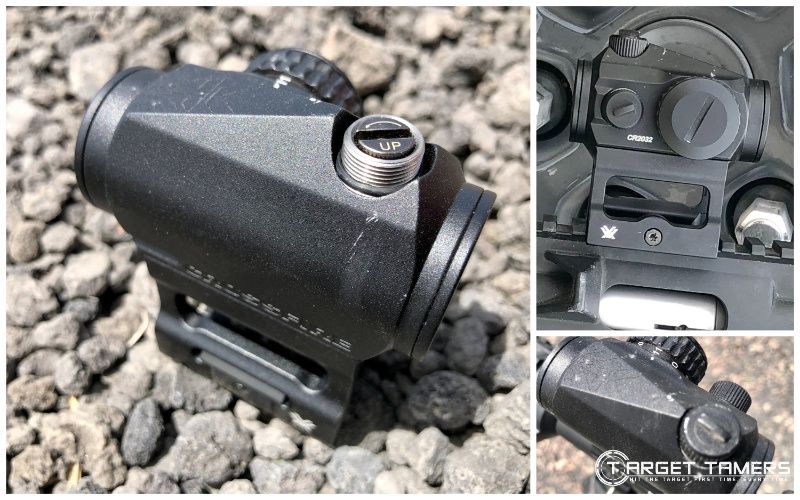
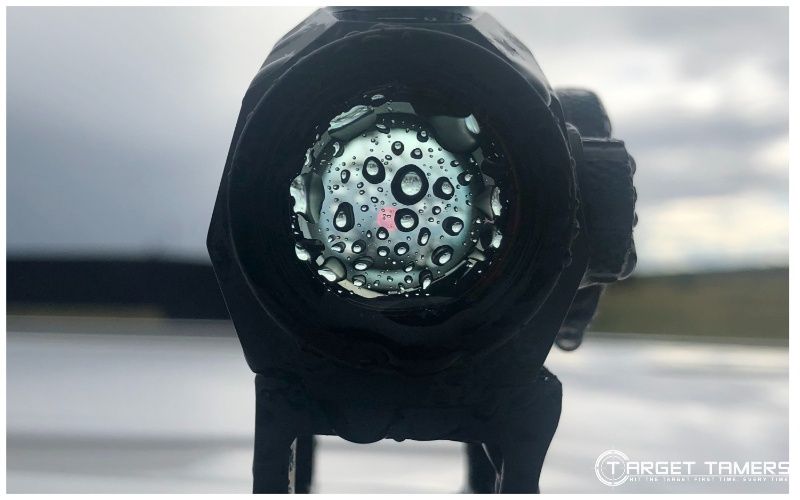
As far as the finish goes, the Crossfire took on surface damage early in the field-testing stage. The Romeo 5 finish has held up well, but you can tell that the finish is wearing around the battery compartment knob. Surprisingly, the Crossfire knob still looks really good.
In general, both have held up extremely well. They’re tough, waterproof, and have handled the conditions I live and work in without issue to the optics, electronics, and overall operation.
Winner: Tie
Dot Size & Astigmatism
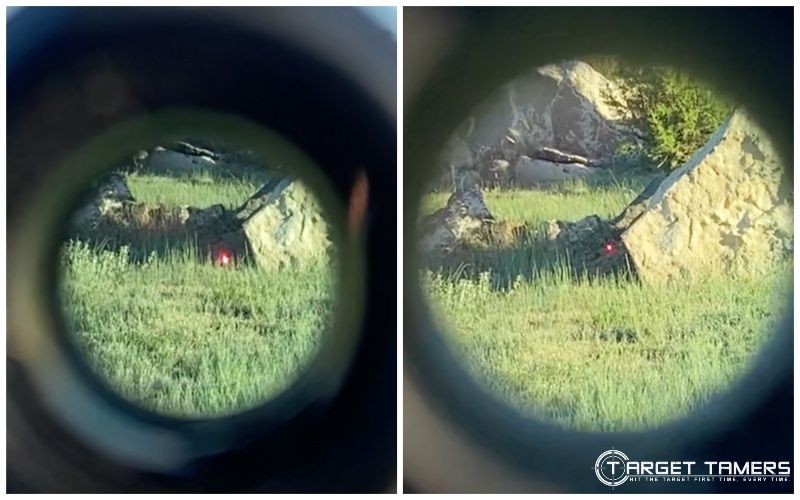
Overall, many rifle red dot sights have 2 MOA dots as the aiming point. It’s a standard dot size and has subtension of 2” at 100 yards. With a 3x magnifier, the dot is now 6 MOA in size. This is generally a non-issue as subtension remains the same because the FOV has also increased in size at 3x.
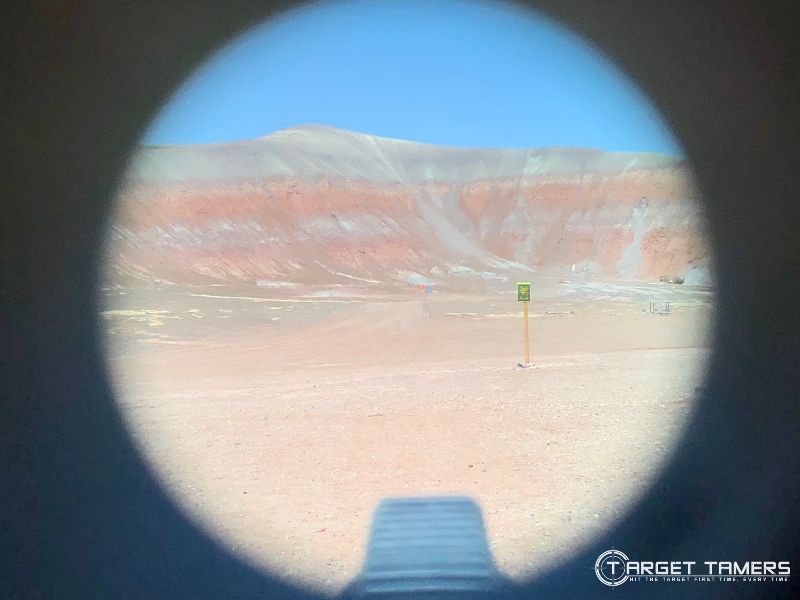
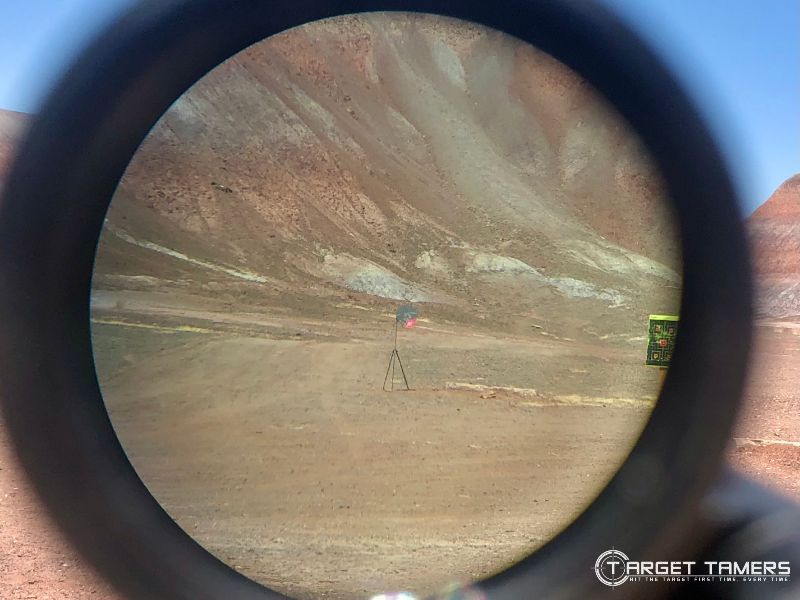
I’ve used both sights with the Sig Sauer Juliet 3 Micro magnifier, and they function as expected. Even though the Juliet has an absolute co-witness height mount, I didn’t bother to add the spacer to match the lower 1/3 co-witness height for the Vortex Crossfire, and it did just fine.
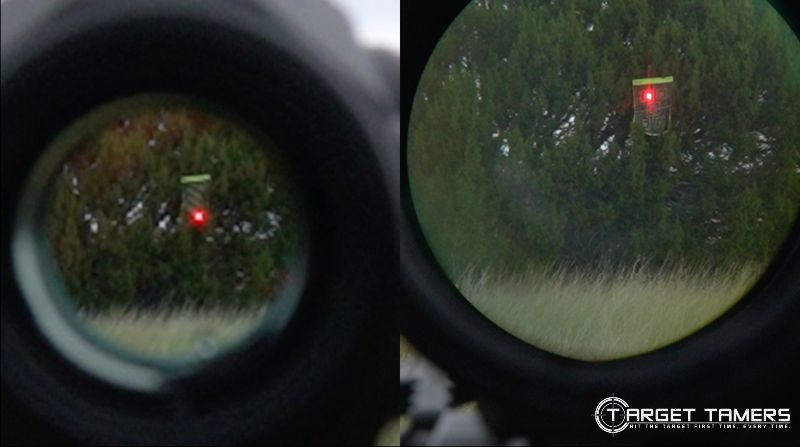
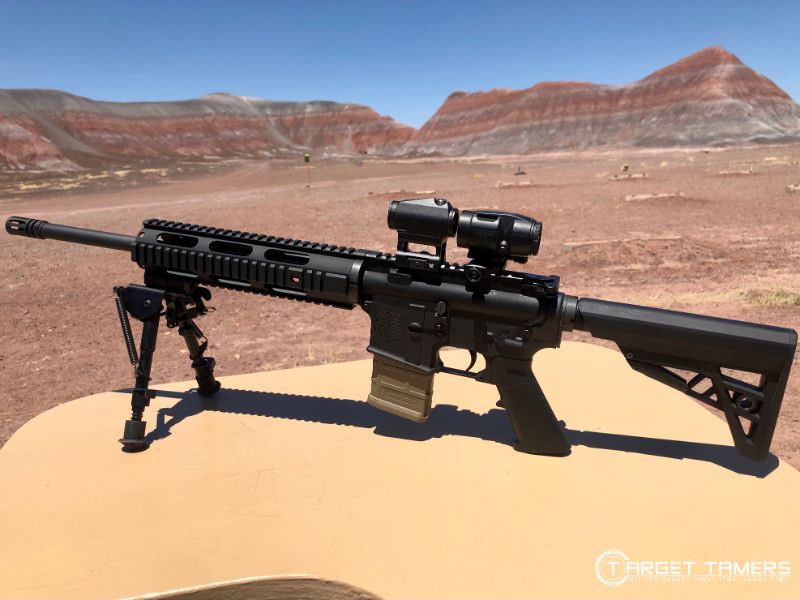
But instead of making this a tie since both dots are the same size, I want to mention dot abnormalities caused by having astigmatism or a refractive error condition.
I don’t wear contacts, so I tend to need my glasses every now and then. Though reflex red dots all work on the same "LED to glass, reflection to eyes" principle, I do better with some and need my glasses for others.
I have no issues with dot fidelity in the Vortex Crossfire. It stayed sharp and round for me, but I did have to wear my glasses with the Sig Sauer Romeo 5.
This is something that will be different for everyone, but as far as my personal experience goes, I preferred the Crossfire.
For more information on the relationship between astigmatism and red dots, check out our solution-based guide!
Winner: Vortex Crossfire
Adjustments
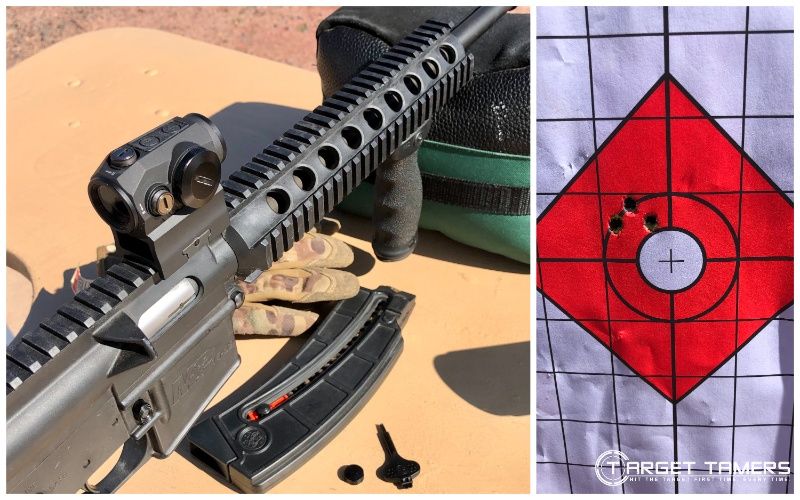
The Vortex Crossfire offers 1 MOA adjustments while the Sig Sauer Romeo 5 offers 0.5 MOA adjustments. The difference is that the Romeo 5 offers more precision accuracy than the Crossfire. This can be beneficial to precision shooters, but 1 MOA is an acceptable standard for red dot adjustments.
Red dots aren’t really known for their precision shooting anyways, but generally, higher quality red dots tend to offer 0.5 MOA adjustments. This is true of the EOTech EXPS3, Aimpoint Duty, and the Trijicon MRO.
Though I think 1 MOA is absolutely fine for probably 98% of buyers, 0.5 MOA fills in the gap for those looking for a little bit more.
Check out our How to Zero a Red Dot guide for step-by-step instructions!
Winner: Sig Sauer Romeo 5
Turrets
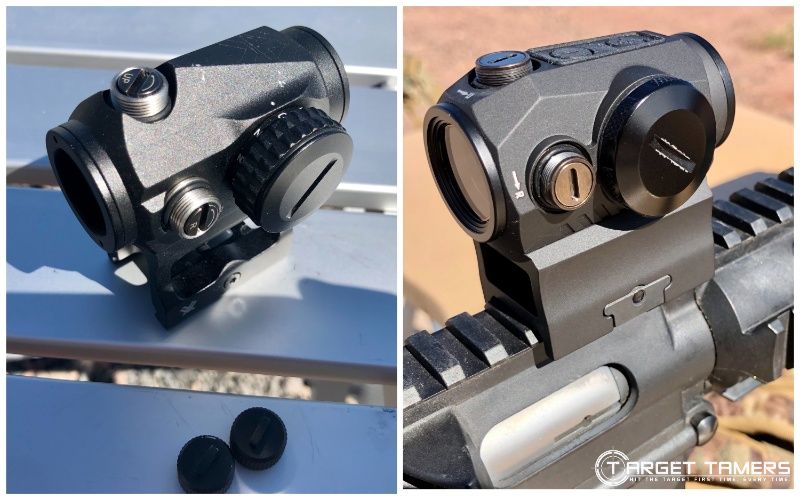
Both the Vortex Crossfire and the Sig Sauer Romeo 5 red dot sights have capped turrets. Both sets of metal caps serve as the tool to make adjustments. The Romeo 5 also comes with a multi-tool that makes adjustments a little more convenient.
The click quality of the turrets on the Vortex Crossfire red dot sight was one of my favorite features. They are tactile, crisp, and have the perfect amount of resistance so that I don't overshoot it. The Romeo 5 performs great too, but I remember being very impressed with my initial experience with the Crossfire out of the box.
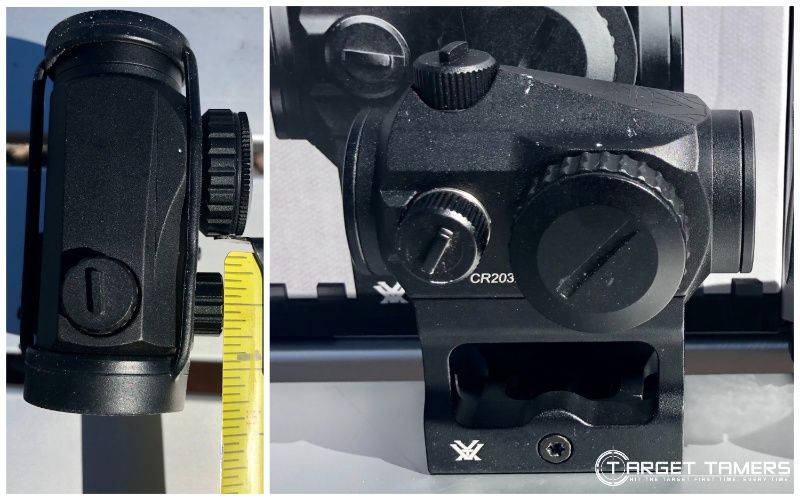
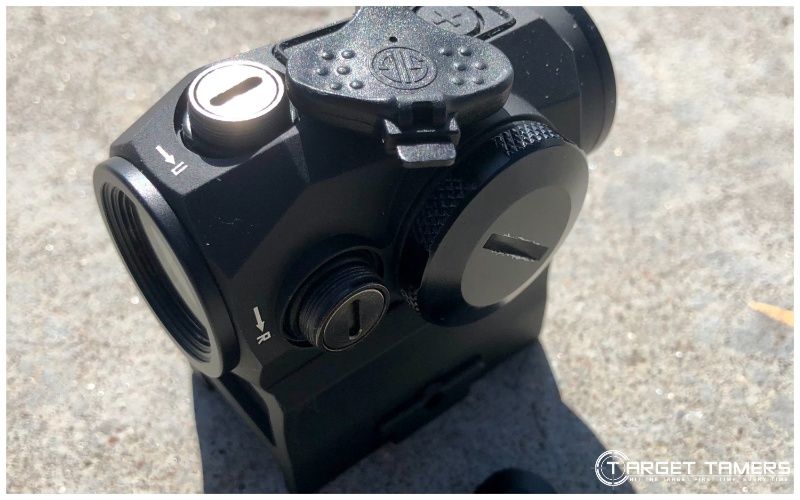
Something that I don’t like about the either the Crossfire or the Romeo 5 is how close the windage turret is to the battery compartment knob. The limited space makes it tedious to get the turret cap off.
Now, both red dots also have slightly recessed elevation turrets. I suppose it gives that little bit of extra protection and snag-free benefits, but it’s frustrating when you need to cap and uncap them.
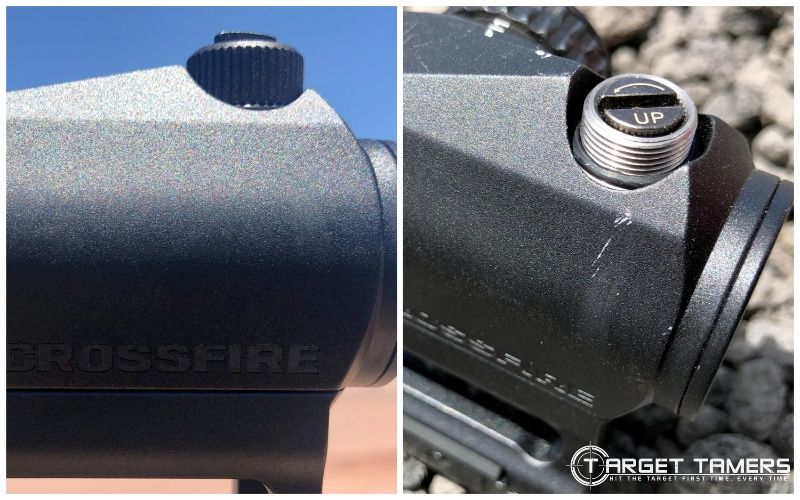
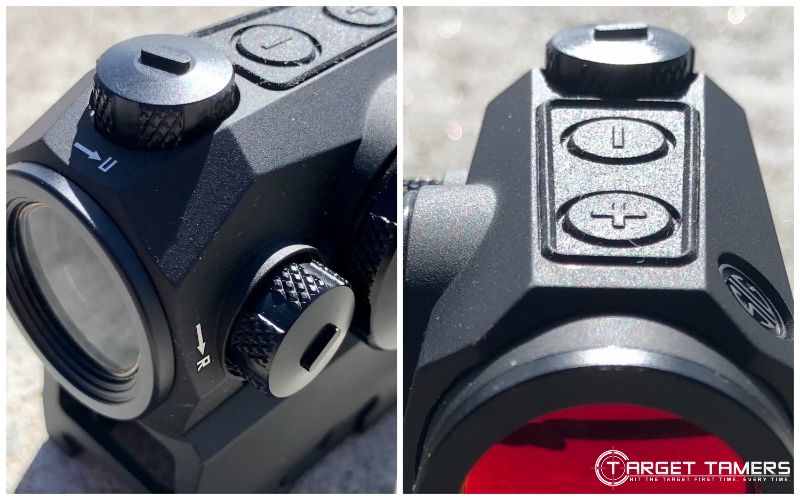
Due to the half-recessed design of the Romeo 5, it’s a little bit easier, but I still find both annoying to deal with. Though the recessed design of the Crossfire is tedious to deal with, the gap between the windage turret and the battery compartment is wider than the Romeo 5.
Winner: Vortex Crossfire
Illumination
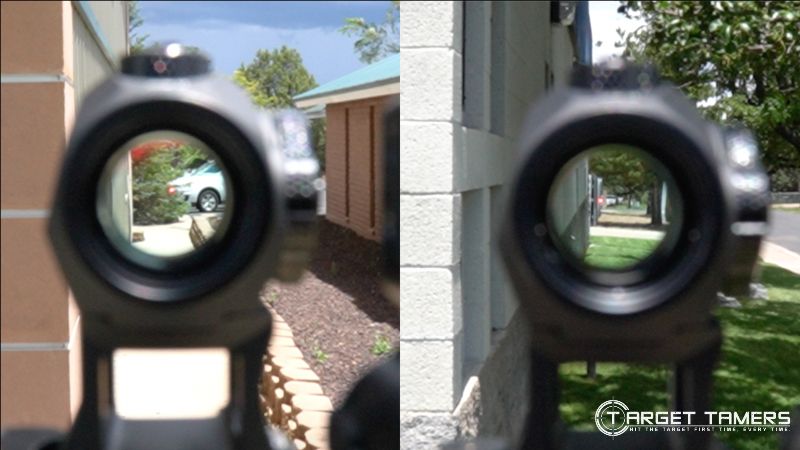
In general, the illumination performance is alike between the Sig Sauer Romeo 5 and the Vortex Crossfire red dot sights. Neither is nuclear bright but can be described as reasonably daylight brightness settings. Both are night vision compatible and are excellent in low light conditions.
The Romeo 5 has eight illumination settings total with two of them safe for use with night vision gear. The Crossfire has 11 illumination settings total with two of them rated for use with night vision.
I sat in the higher settings in most conditions with both red dots. I couldn’t see illumination in daylight conditions at 5 and lower with the Crossfire. With the Romeo 5, setting 5 was my limit for daylight conditions also.
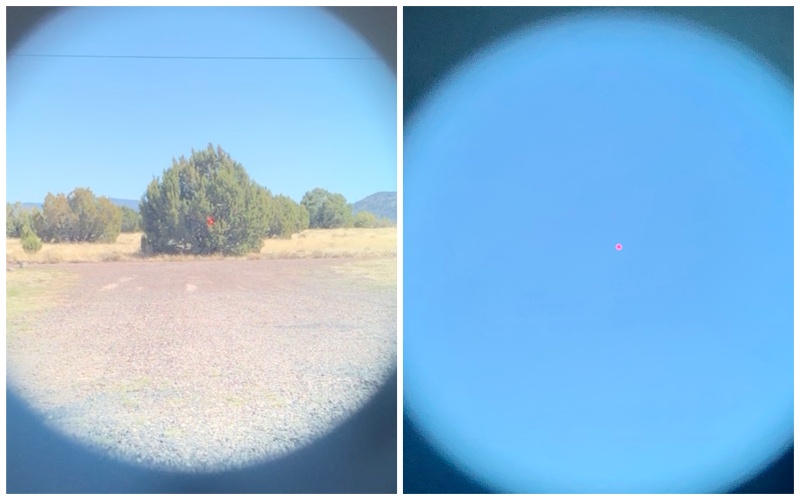
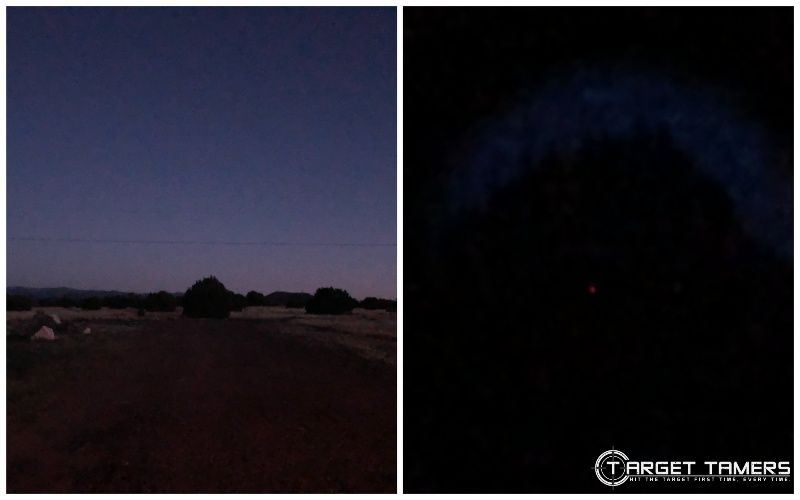
Both are excellent in low light and in the dark. With the dim settings, there’s no blooming or starbursting. But because the Crossfire offers more illumination settings (11 total) that has proven to have practical visibility in daylight conditions, it wins out the illumination race.
Winner: Vortex Crossfire
Illumination Control
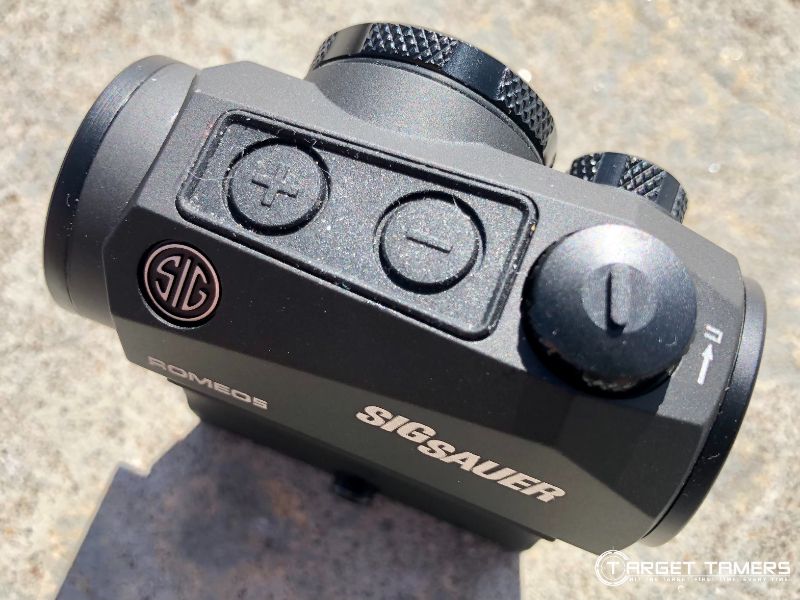
Many people don’t give much thought to the illumination control whether it’s buttons or a rotary dial. To those who do think about it, there is a personal preference. The Vortex Crossfire incorporates a dial/knob while the Sig Sauer Romeo 5 has button operation.
I’m personally bias to rotary dials, but they need to be done right. That means they have good resistance but are not too stiff, and they must be able to rotate both forwards and backwards past the off or ‘0’ setting. With these conveniences, intermittent off positions are not so much of a priority – in my opinion.
This is where the Crossfire lets me down. It’s what I would consider oversized, but it does not rotate past 0, and it’s on the stiffer side. What really knocks it down an extra notch is that it’s very close to the windage turret making it awkward to use freely.
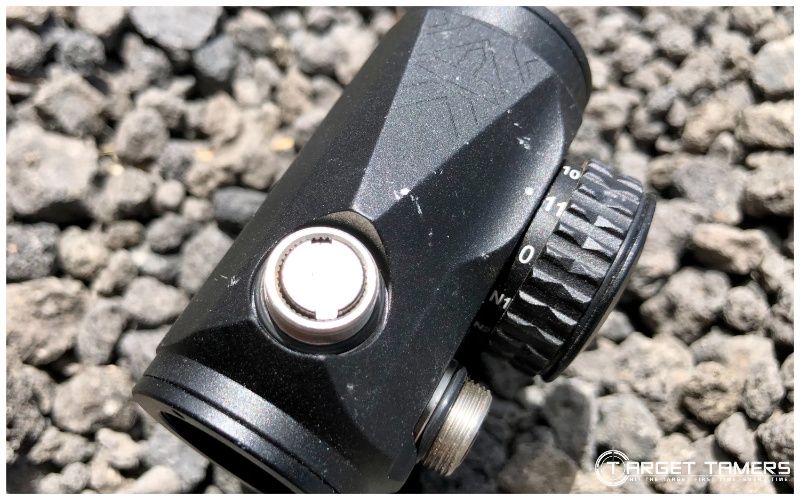
Though I like knobs, I much prefer the button operation on the Romeo 5. It’s easy to use, and there’s nothing getting in the way of using it. They’re not easy to find with gloves on, but with the naked hand, it does its job.
I will point out that if you change the battery, you must hold down the + button to activate the illumination and crank it up until you can see it. I don’t like that the default setting after a battery swap is the lowest illumination.
Winner: Sig Sauer Romeo 5
Battery Life (Plus Update!)
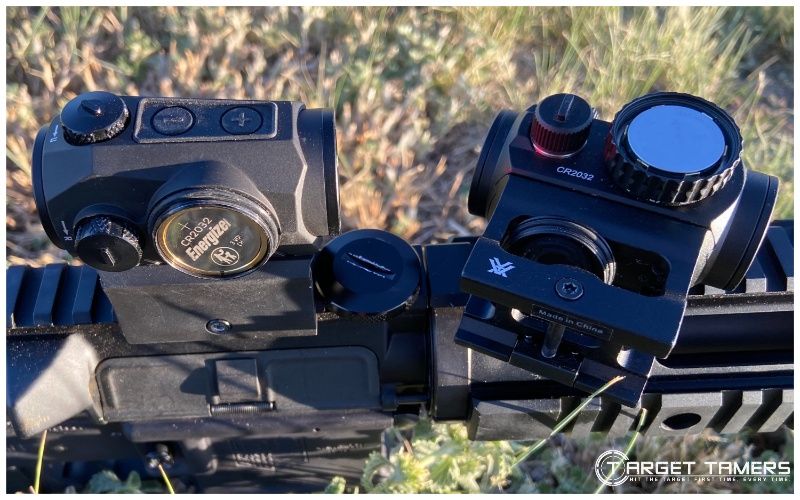
The battery life of a red dot sight is a selling point. Industry-best runtimes for red dots these days is 50,000 hours. This is quite the feat and proof of optical advancements even in the affordable red dot sight market. The Vortex Crossfire beats out the Sig Sauer Romeo 5 by 10,000 hours.
UPDATE: The battery that came with the Crossfire has run out of juice. The runtime off the battery was 10,220 hours (approximately) – just over a year. That’s really not bad at all as I think it’s acceptable to change out a battery once a year. But it’s still far shorter than what it’s rated and advertised for. The older gen Crossfire had a 7,000-hour battery runtime, so it does raise an eyebrow or two.
I want to speculate that it’s due to the battery. You never really know how much power you’re actually going to get with an included battery out of the box. Going forward, time will tell how long a fresh battery will keep the Crossfire running.
The Romeo 5 is still going after 10,000+ hours, and I haven’t had to change it yet. Though it’s technically running longer than the Crossfire out of the box, I still want to speculate that if I were to give each a new battery and test it from there, the Crossfire would come out winner.
However, this is all just speculation. What happened out of the box is that the Romeo 5 is still going, and the Crossfire isn’t. Could it be a fluke? Yeah, but it could also be a precedent for what’s to come. Specs on paper is one thing, but what happens in actual use in the field is another. It’s why the Romeo 5 gets it.
Winner: Sig Sauer Romeo 5
Mounts & Co-Witness (Plus Update!)
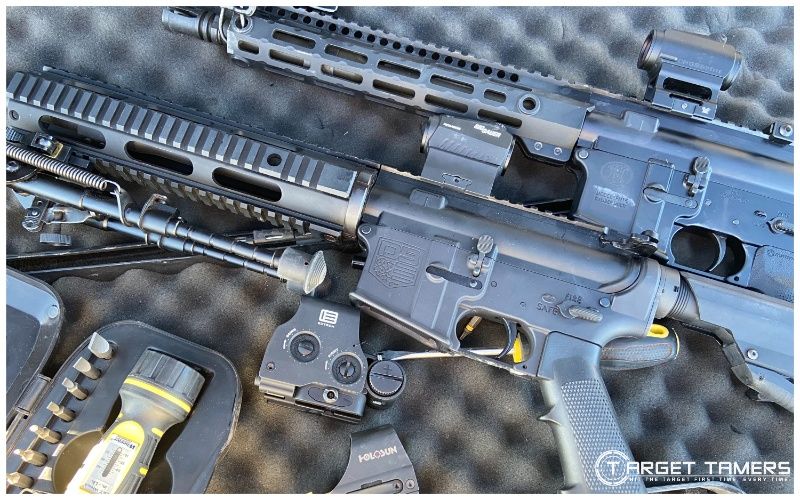
Red dot sights nearly always come with an included, pre-installed mount. The Sig Sauer Romeo 5 comes with a 1.41” absolute co-witness mount and a low-profile mount in the box. The Vortex Crossfire comes with a lower 1/3 co-witness mount and a low-profile mount in the box.
It’s great that low-profile mounts come in the box with both red dot sights. I’ve used the low mount on a Ruger 10/22 and on a muzzleloader. They do the job excellently – no complaints.
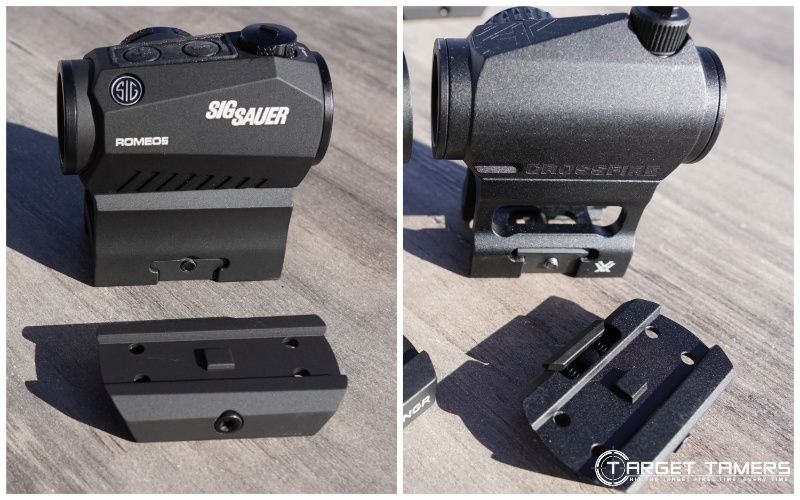
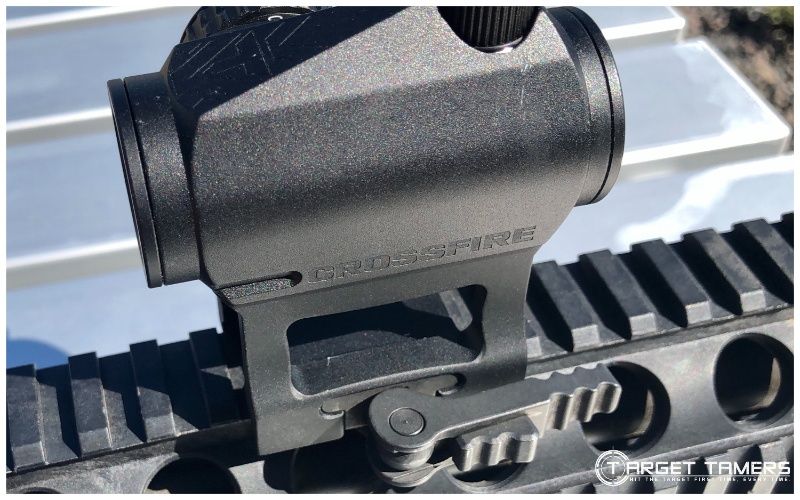
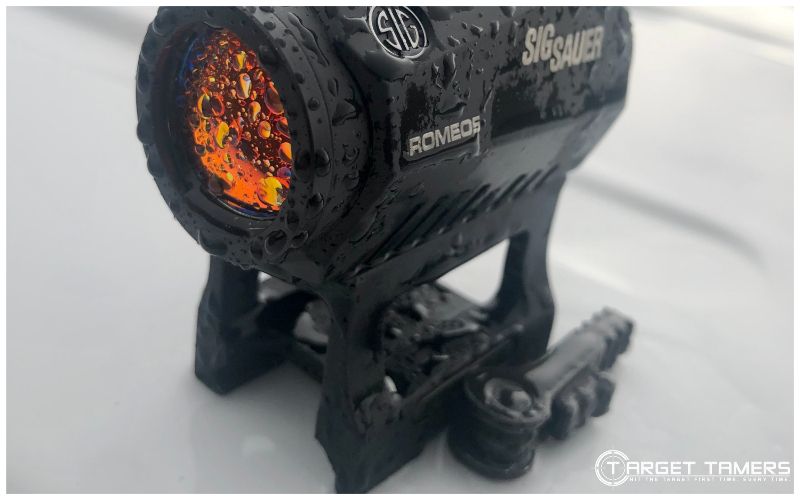
Personally, I like the skeletonized look of the riser mount on the Vortex. I’ve always liked this design style, so it makes sense when I say that I think the Romeo 5 riser mount is less appealing. But that’s just my opinion based on looks.
As far as absolute versus lower 1/3 co-witness height mounts, it’s a tie because it’s a personal preference. One might prefer one co-witness height because it matches the height of their magnifier, or they might prefer that type of co-witness for iron sight visibility through the RDS.
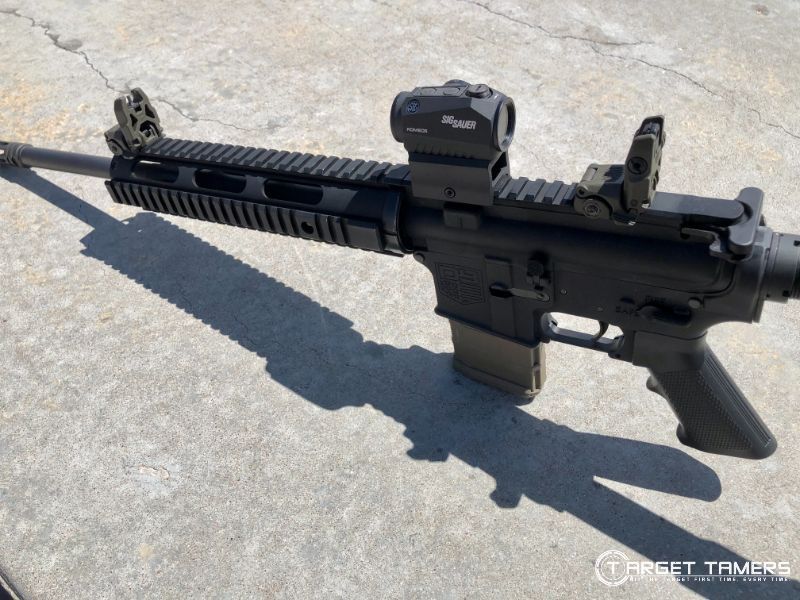
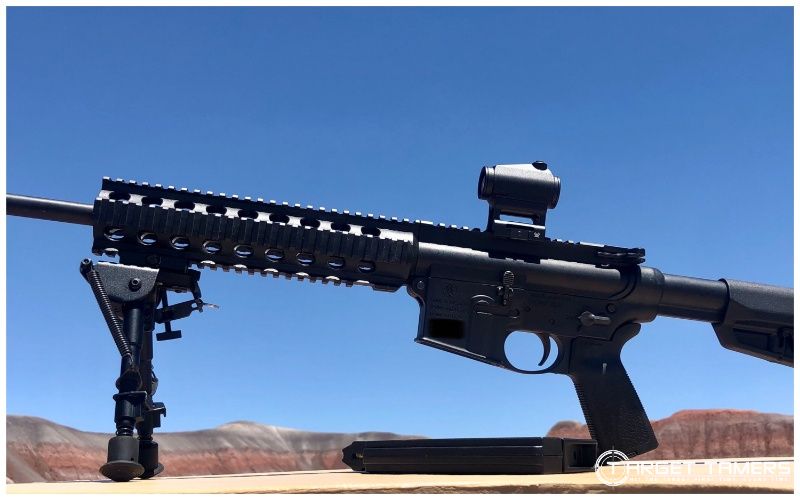
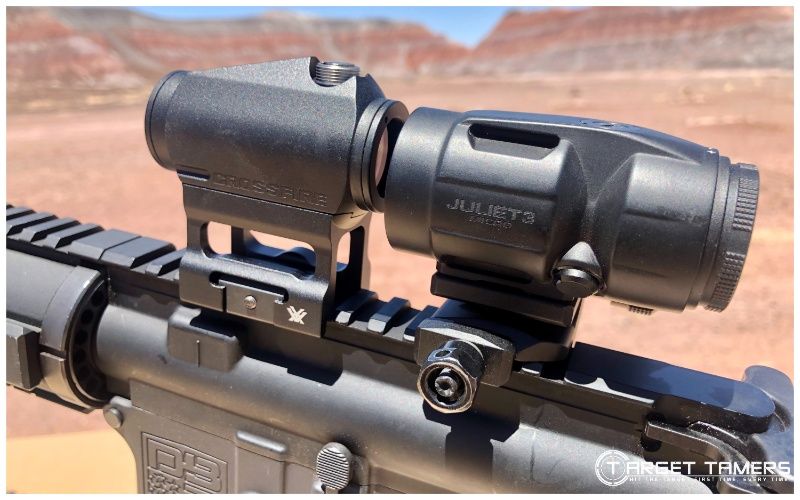
I don’t have a preference for either co-witness as I use my iron sights as a secondary and independent sighting system. I also have spacers for my magnifiers if needed too. But recent developments have me favoring the Vortex Crossfire.
UPDATE: I was out with the Romeo 5 recently and didn’t dismount it right away. When I went to dismount it, I found that it’s stuck solid on the rail. I didn’t over torque it when mounting, so I don’t know what happened. I’ve broken a bit trying to get it unstuck. I’ll get a T10 torx bit for my torque wrench – that should do it.
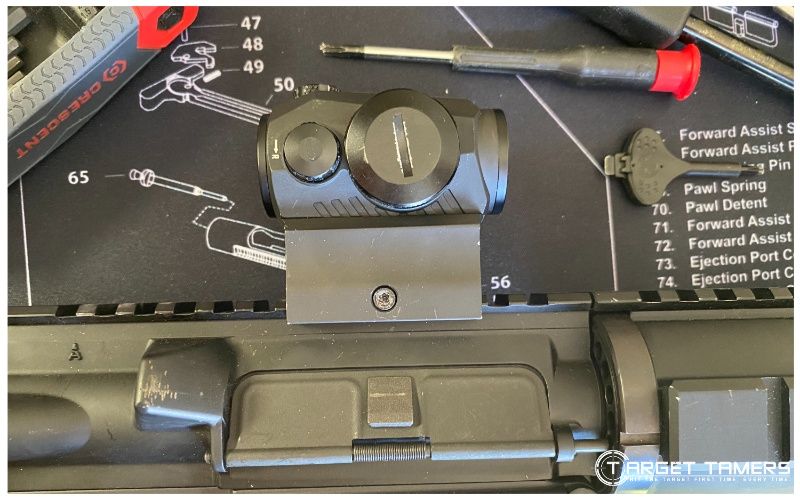
The next day: It didn’t do it. I stripped the screw. I’m really mad about it. I’ll try a screw extractor kit next.
Because I’m still sore about this, I’m giving mount looks (aesthetic appearance), mount quality, and mount convenience to the Crossfire.
Winner: Vortex Crossfire
Size & Weight
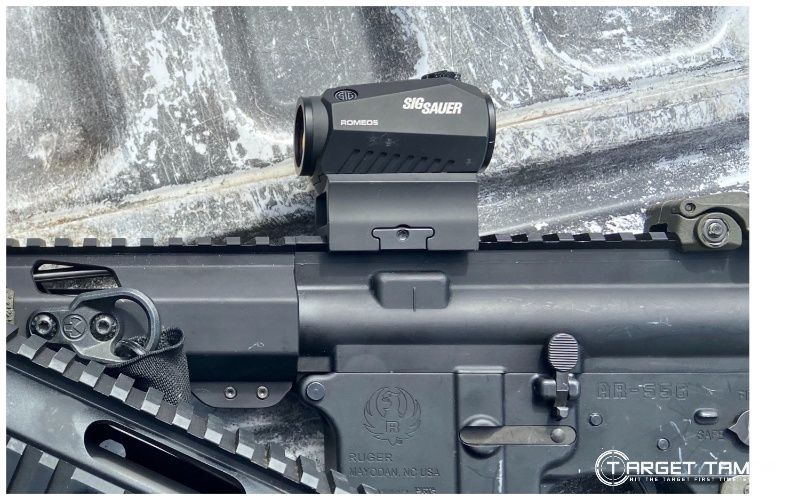
Both the Sig Sauer Romeo 5 and the Vortex Crossfire are closed micro red dot sights. As such, they’re lightweight and compact. According to the specs, the Crossfire weighs 5.2 oz and the Romeo 5 weighs 5.1 oz. It’s a wash between them in weight. When it comes to size, they’re neck and neck.
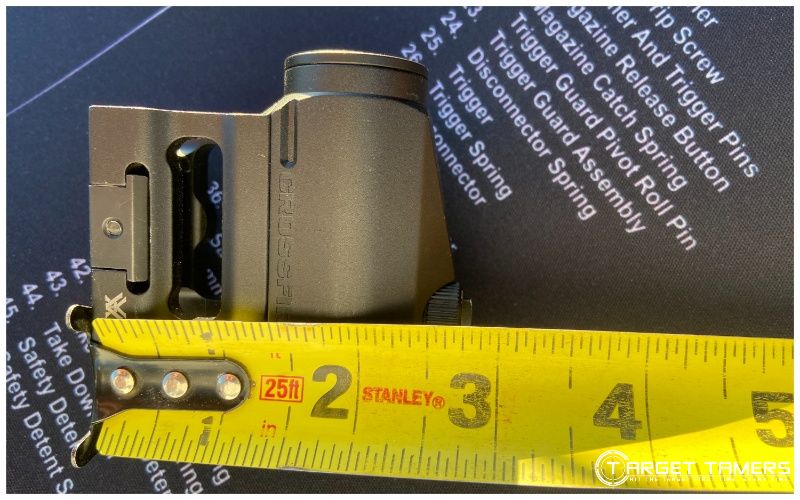
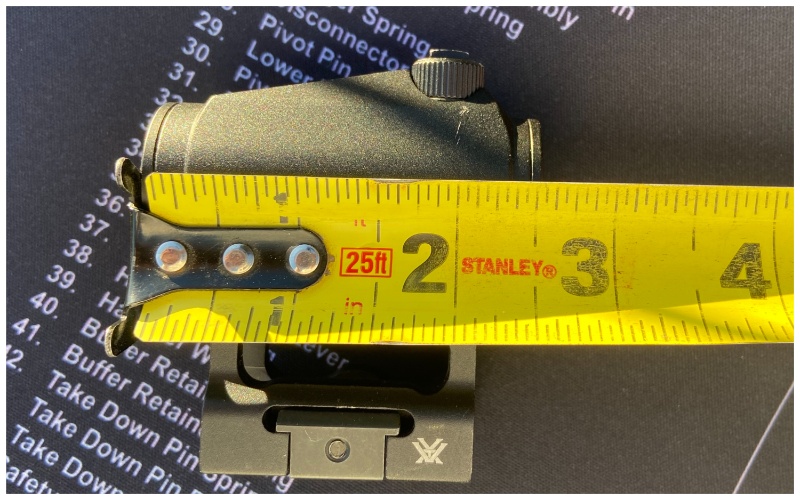
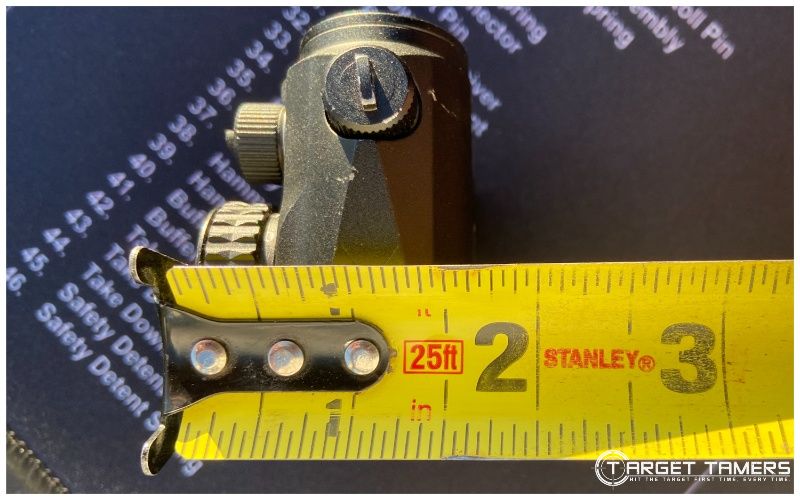
Vortex only lists the length spec for the Crossfire at 2.5”. That’s accurate. I measured the total height and came up with 2.8” from the tip of the elevation turret to the base of the mount. I also measured 1.7” in width from the outer edge of the illumination knob to the other side of the Crossfire tube.
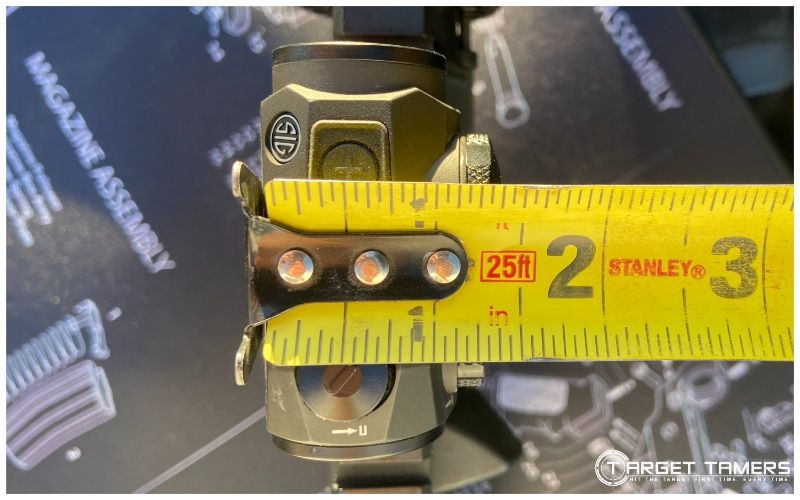
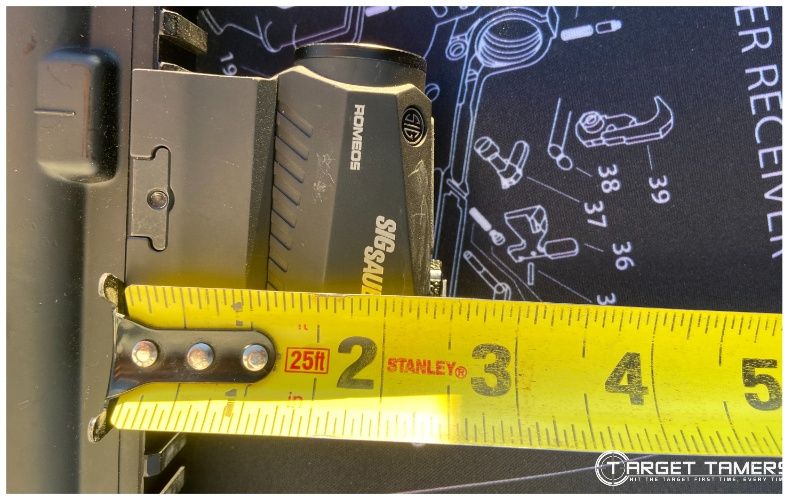
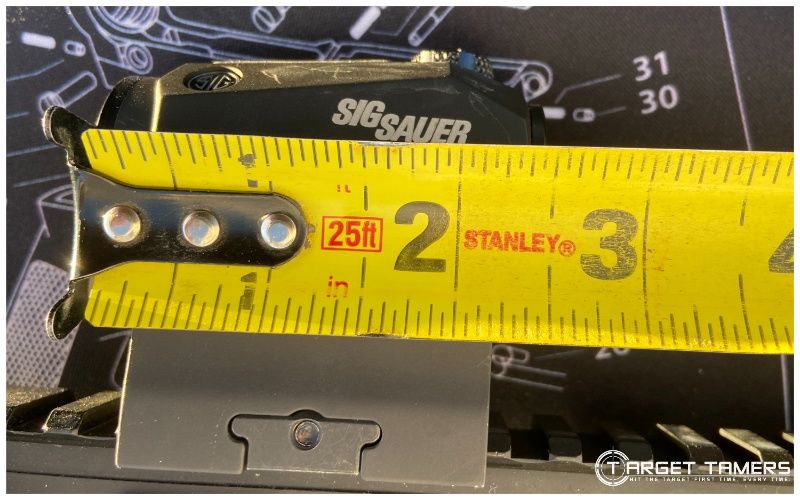
I give a different measurement for the Romeo 5 based on my measurements and not the listed specs. Though they get it right in length (2.4”) and width (1.5” but I measured 1.4"), they listed the height spec as 1.5”. This is true of the Romeo 5 tube, but it does not include the mounting height. The total height I measured is 2.5” from the tip of the elevation turret to the base of the mount.
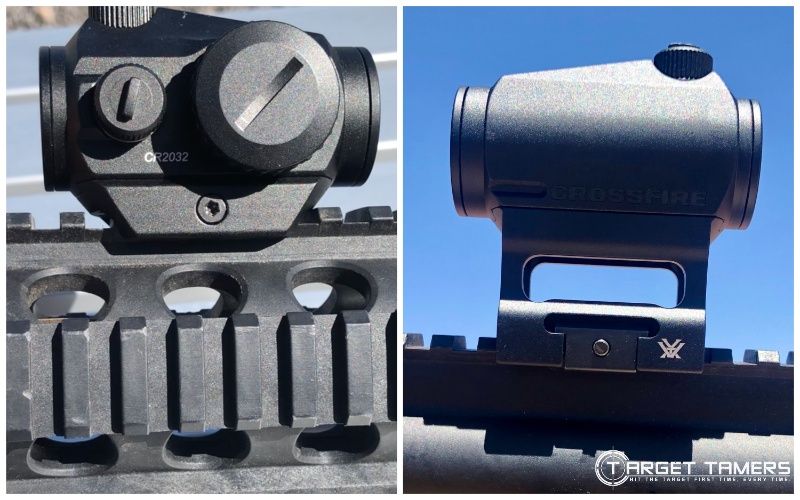
They’re about the same in size and weight with no real differences between them. The Crossfire mount takes up about 4 rails and the Romeo 5 takes up about 5 rails on a Picatinny rail. Just because you're saving one rail with the Crossfire, I'll give this to the Vortex RDS. I probably got a little nit-picky about the dimensions, but it might be worth knowing.
Winner: Vortex Crossfire
Special Features

Special features are attributes that are worth spotlighting to differentiate between quality, value, and performance improvements. In this case, a special feature of note in the Sig Sauer Romeo 5 is the MOTAC technology. In the Vortex Crossfire, the continuous-on benefit is a worthy distinction.
MOTAC stands for Motion Activated Illumination. There is a sensor on the Romeo 5 that detects movement. It automatically activates the illumination after a period of 120 seconds. I confirmed this during field testing, and it works as it should. It is very sensitive, so long as there's no battery failure, the MOTAC should not fail you.
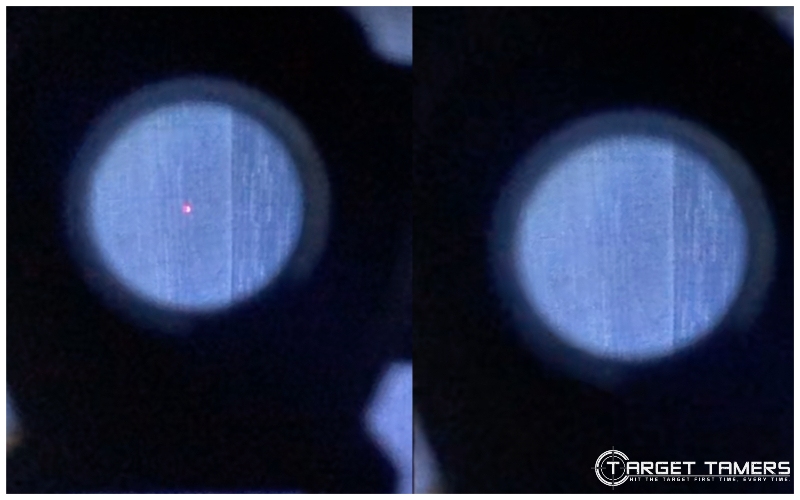
I also want to mention that the MOTAC is not adjustable. You can’t adjust the 120-second sleep timer for a shorter or longer time.
MOTAC is a feature that many like to have on their duty rifles for work or for a home defense rifle. I would even say that some may want it for target shooting because remembering to turn off the red dot seems to be a hard thing to do for some people.

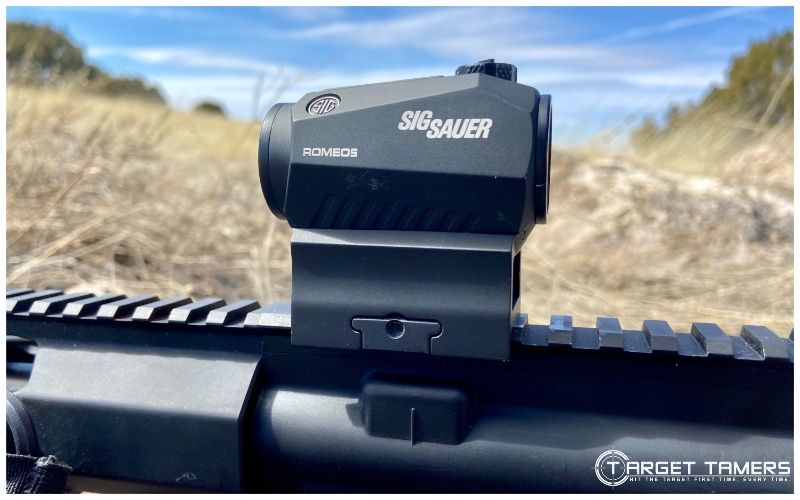
Either way, there’s a market for motion sensor technology, and I sure don’t mind having it on the Romeo 5. It’s certainly a battery conservation feature that I appreciate and may be why I haven’t needed to change out the battery yet.
As for the Crossfire, it’s a continuous-on red dot. It does not have a motion sensor. Given that I don’t like to use the illumination knob too much on the Crossfire, I like that it has an incredible 50,000-hour battery life – at least on paper. Though I half expect to change out the battery once a year, it’s far from the end of the world for me.
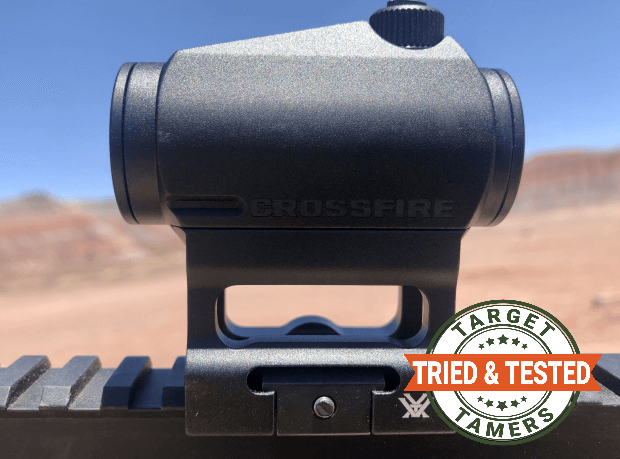
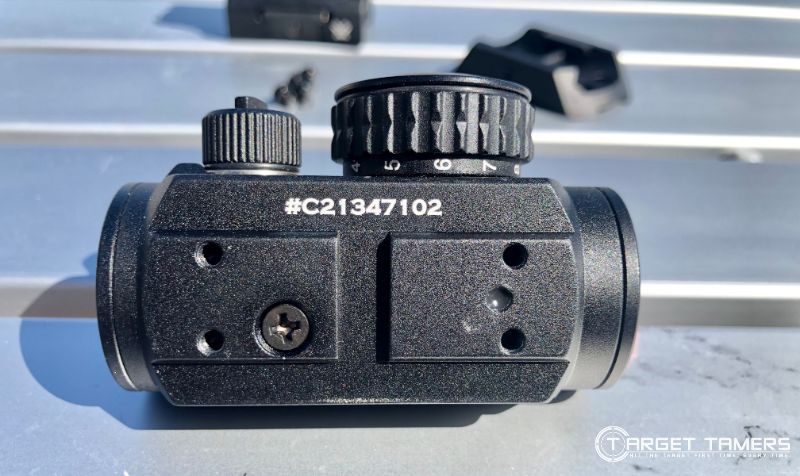
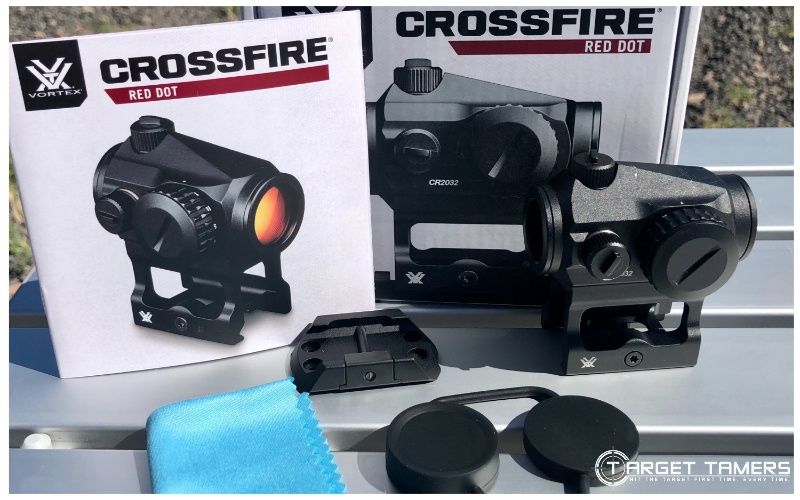
I can leave it on, I don’t have to rely on a motion sensor to do its thing, and I’m 99% confident I’ll always have a dot. That 1% doubt is just because it’s still a battery-powered optic – failure can happen.
There are pros and cons to both these operating systems, but it will come down to application and personal preference.
Winner: Tie
Who is the Vortex Crossfire Best Suited To?
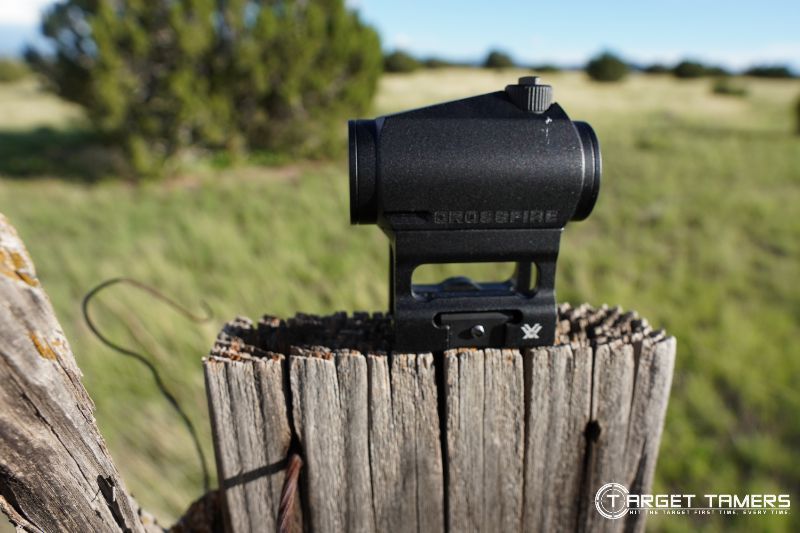
Overall, the Vortex Crossfire is a good, entry-level red dot with affordability at its core. It’s the cheapest Vortex red dot sight available and is straightforward in design and operation. As a budget RDS, I recommend it for beginners, some hunting, and definitely for target shooting fun.
Though there are things about it that I really don’t like, such as its recessed turrets and illumination knob, I do prefer its continuous-on operating system, its simplicity, potential industry-best battery runtime, and the mounting system.
It’ll serve most applications well but if you’re looking for a duty-grade red dot for professional uses, I’d recommend considering an upgrade. For those looking for a quality red dot for AR-15 or rimfire rifles, the Crossfire is a good pick.
Who is the Sig Sauer Romeo 5 Best Suited To?
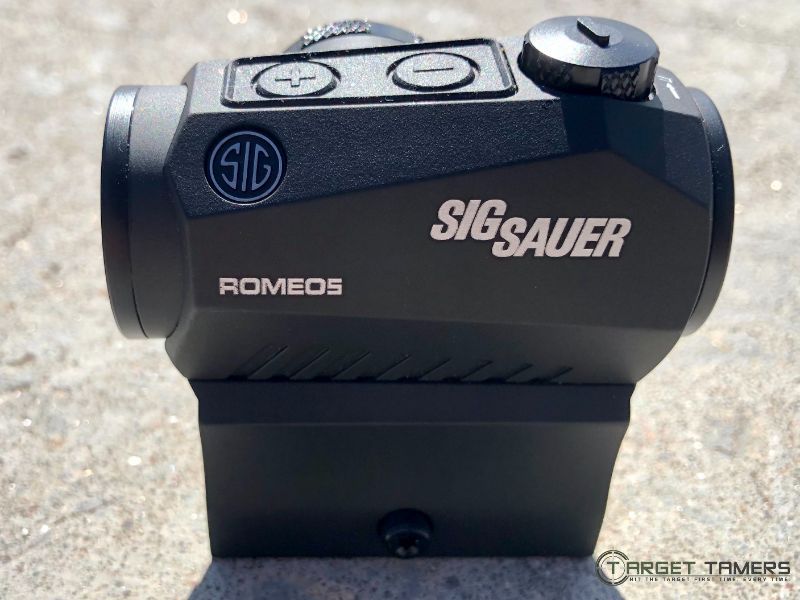
The primary feature that will attract buyers to the Sig Sauer Romeo 5 is the MOTAC technology. It’s not often seen in red dots under $150, so the Romeo 5 stands out as a top-tier red dot sight in the entry-level market.
Buyers who might find MOTAC useful include those in law enforcement who want a budget but quality optic. Civilians may look to top their SHTF or home defense rifles. I'll bet that there are those who shoot recreationally every once and a while will want MOTAC to eliminate the step of manually turning off the red dot.
To be as down to earth as possible, I will admit that I’m upset with the stuck mount, and it’s far from the sexiest looking red dot sight available. Even with that said, I do think its optical quality is superior to the Vortex, and I definitely preferred its button operation to the stiff knob on the Crossfire.
I often shoot with the Romeo 5 on an AR-15 and 15/22. I pair it with the Sig Sauer Juliet 3 magnifier almost all the time, and it’s held up exceptionally well with all the dirt, rain, and knocks I’ve put it through.
FAQ's
Red dot sights are excellent for close-range engagements and is often used inside 100 yards. However, the 0.5 MOA adjustments of the Sig Sauer Romeo 5 will lend itself better to precision shots at distance over the Vortex Crossfire red dot sight.
Vortex Crossfire on 100-yard target - Image by Tina Fa'apoi (Own Work) for Target Tamers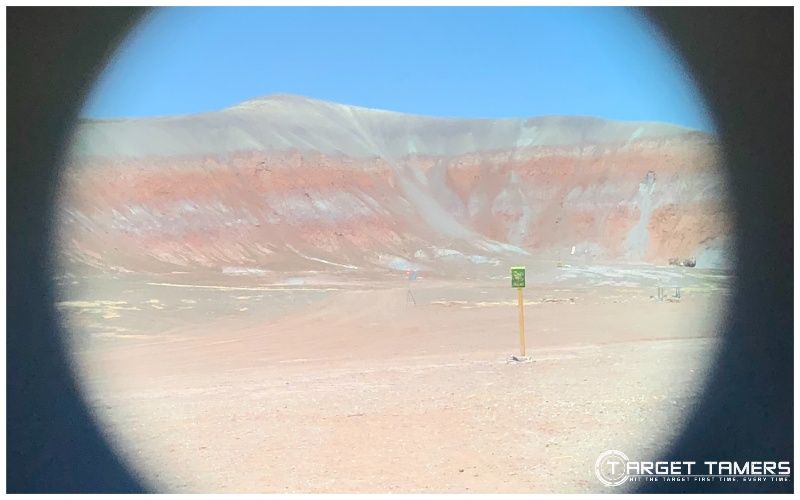
On average, both the Sig Sauer Romeo 5 and the Vortex Crossfire will work well for shotguns. Included in the box are low-profile mounts that may be preferred over the pre-installed riser mounts.
The MOTAC in the Romeo 5 is very sensitive, and it is very likely that the illumination will be activated and continuously on in a patrol vehicle that is a daily driver. Though battery life is rated at 40,000+ hours, I’d recommend changing out the battery once a year for law enforcement use.
Image by Tina Fa'apoi (Own Work) for Target Tamers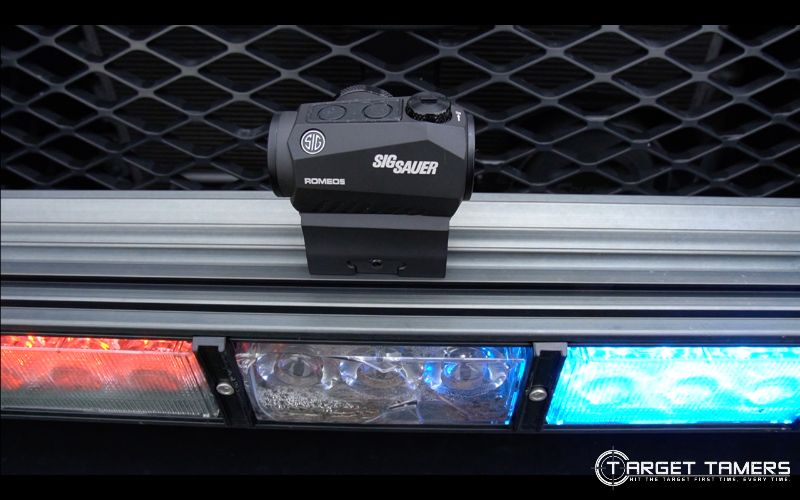
In general, the Crossfire and Romeo 5 red dot sights are intended for rifles, but they can be mounted to pistols with a rail, and of course, to carbines and AR pistols. They can be oversized and large for handguns, but it would mount, and I’d recommend the low-profile mount.
I’ve seen this done, but my recommendation is to buy a micro pistol red dot sight intended for pistols.
Image by Tina Fa'apoi (Own Work) for Target Tamers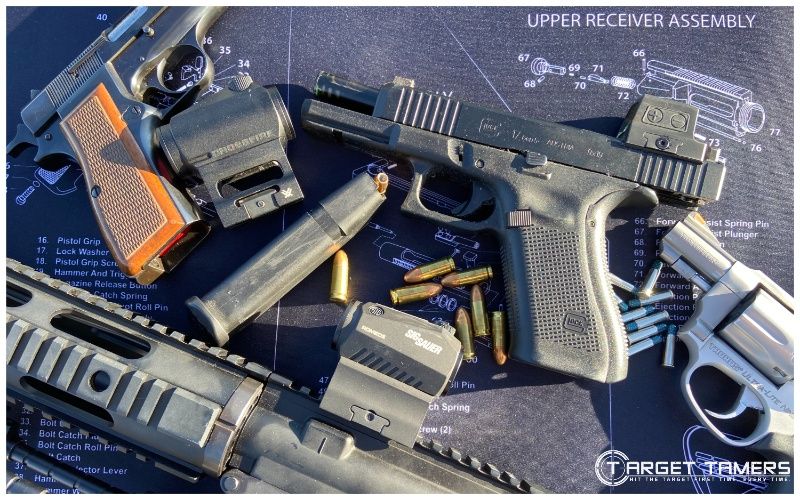
Overall, Vortex Optics has the best warranty. Their VIP warranty reputation precedes them. It’s an unconditional, unlimited, lifetime warranty. It’s fully transferable, no paperwork required, and it’s across the board for all their optics.
Sig Sauer has an Electro-Optic Infinite Guarantee warranty that is similar to the Vortex VIP warranty but not quite as good. That’s because the warranty is technically split in two for battery-powered optics. The LED system is only covered for five years.
Sig Sauer Romeo 5 VS Vortex Crossfire: Which is Best?
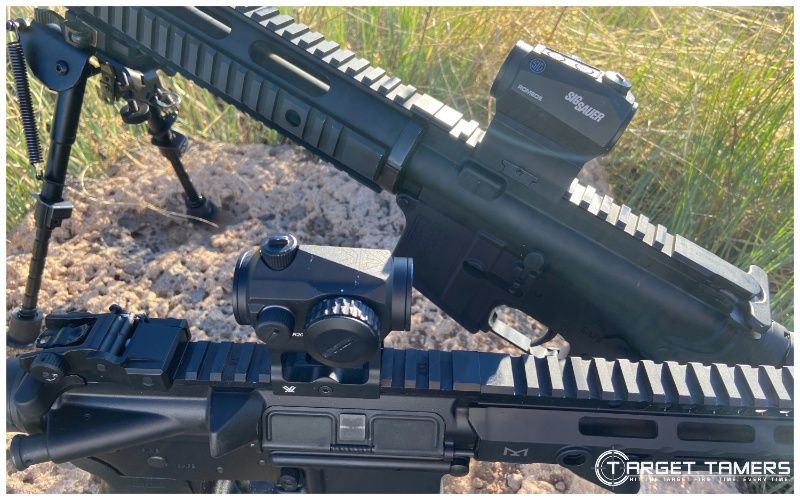
The Sig Sauer Romeo 5 red dot sight has MOTAC, button operation, and very good glass for its price point. The Vortex Crossfire red dot sight is a continuous-on optic with a sharp, round dot, and is easy to use. It also has an industry-best warranty for buyer confidence.
By now, it should be clear where on the Vortex Crossfire VS Sig Sauer Romeo 5 debate you land. Both are in the same price range, they’re great entry-level red dot sights, and they’re both built with ruggedness in mind. It’s a tough choice, but there are enough differences between them that one must stand out to you by now.
Further Reading

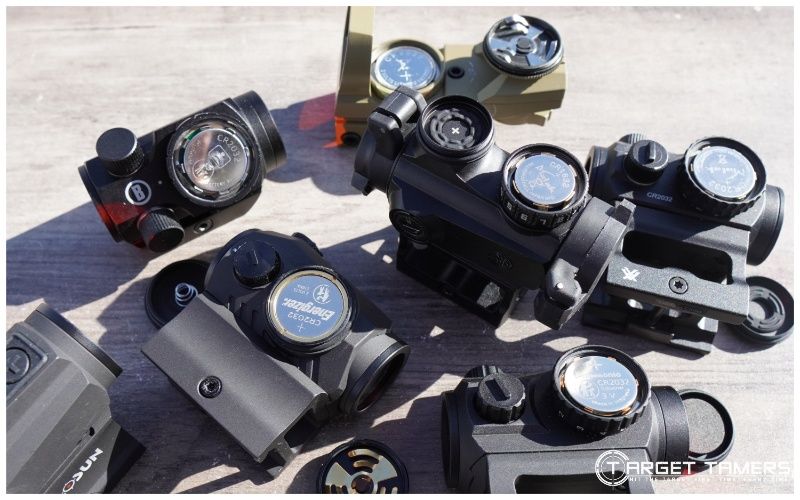



I was quite confused between sig sauer and and vortex scopes but thankfully I came across this post. How insightful is your in-depth analysis of the Sig Sauer Romeo 5 and the Vortex Crossfire? Potential customers can learn a lot from your practical evaluation of these red dot sights and your hands-on experience.
The detailed feature breakdown, which covers everything from construction durability and dot size to pricing and optical quality, is beneficial for anyone looking for the best fit for their particular requirements. Your individual experiences with finish durability and water tests give the comparison a useful edge.